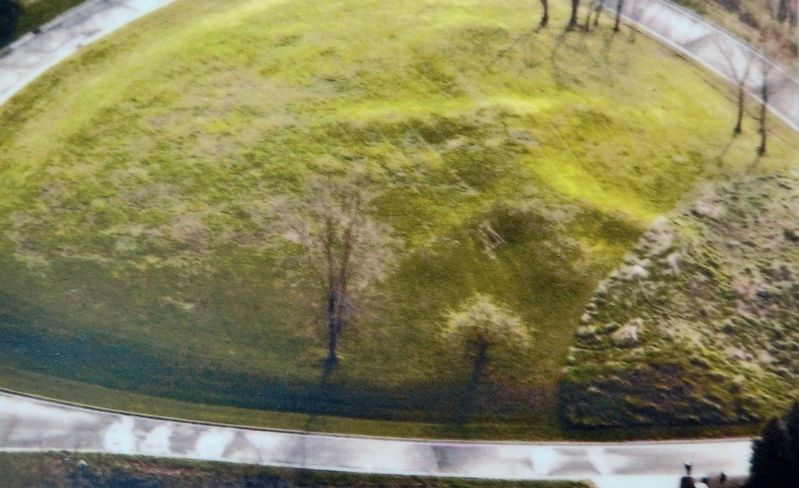Granville in Licking County, Ohio — The American Midwest (Great Lakes)
Granville's Earliest Residents
Humans have lived in the region of Granville Township for thousands of years. Much of what we know of the Indigenous peoples is inferred from the stone tools and adornments left behind, discovered when land was plowed for farms and homes were built. This area is known for groups, collectively referred to as Mound Builders, who created earthworks on the land. These groups are classified by names given by modern scholars as follows:
Adena culture, 800 BCE to 100 CE
Hopewell culture, 100 BCE to 400 CE
Fort Ancient culture, 900 CE to 1650 CE
These groups of people built many mounds in the region, most of which have been destroyed for farms or building purposes. One mound still intact is an effigy mound referred to as the Alligator Mound, believed to be from the Fort Ancient culture. It is one of only two known effigy mounds in Ohio. Even though it is called an alligator, it may represent another animal, perhaps even one that is mythical.
At the time of European American exploration, Wyandot, Shawnee, and Delaware peoples lived in this region. In 1795 the Treaty of Greenville was signed between the United States and many Indigenous nations, including the three mentioned, in which the natives gave up their claims to certain land in present-day Ohio. Soon after, speculators and settlers took advantage of the opportunity. When new settlers moved to the area of present-day Granville there was still a group of Wyandot living in what is now called the Welsh Hills. There is some dispute as to the exact location of their village, but the Wyandot remained until about 1807, according to reports from the Welsh. There is no record of why they left.
Erected 2022 by Granville Historical Society; and Granville Community Foundation.
Topics. This historical marker is listed in these topic lists: Anthropology & Archaeology • Native Americans • Settlements & Settlers. A significant historical year for this entry is 1795.
Location. 40° 4.064′ N, 82° 31.168′ W. Marker is in Granville, Ohio, in Licking County. Marker is at the intersection of East Broadway (Ohio Route 661) and Linden Place, on the right when traveling east on East Broadway. Marker is located in the garden courtyard directly in front of the Granville Historical Society Museum. Touch for map. Marker is at or near this postal address: 115 East Broadway, Granville OH 43023, United States of America. Touch for directions.
Other nearby markers. At least 8 other markers are within walking distance of this marker. Granville's Broadway (here, next to this marker); Bank of the Alexandrian Society (here, next to this marker); Granville's Welsh Hills (here, next to this marker); St. Luke's Episcopal Church (a few steps from this marker); Founding of Granville, The Licking Company / The Granville Site, "The most eligible part" (within shouting distance of this marker); Granville Opera House (within shouting distance of this marker); Bolen Memorial Park (within shouting distance of this marker); The First Presbyterian Church of Granville (about 300 feet away, measured in a direct line). Touch for a list and map of all markers in Granville.
Also see . . .
1. Alligator Effigy Mound.
The exact creature depicted in the 217-foot, nearly acre-sized mound is unknown, yet the moniker “Alligator Mound” has remained with the site. Originally attributed to the Hopewell culture that built the nearby Newark Earthworks, radiocarbon dating has placed the construction of Alligator Mound between 1100 and 1300 CE, more than 500 years after the decline of Hopewell culture. The site is now understood to be part of a broader cultural movement of effigy mounds constructed in the Ohio River Valley region known as the Fort Ancient culture which includes Ohio's Serpent Mound.(Submitted on September 21, 2022, by Cosmos Mariner of Cape Canaveral, Florida.)
2. Treaty of Greenville - 1795.
Redefined the boundary between indigenous peoples' lands and territory for European American community settlement. It ended the Northwest Indian War in the Ohio Country, limited Indian country to northwestern Ohio, and began the practice of annual payments following the land concessions. The parties to the treaty were a coalition of Native American tribes known as the Western Confederacy, and the United States government represented by General Anthony Wayne and local frontiersmen. The treaty became synonymous with the end of the frontier in that part of the Northwest Territory that would become the new state of Ohio.(Submitted on September 21, 2022, by Cosmos Mariner of Cape Canaveral, Florida.)
3. Granville museum takes village’s history outdoors.
The “Granville’s Earliest Residents” board includes a map of the area’s Native American mounds. An aerial photo of the Alligator Mound on the hill at the end of Bryn Du Drive was provided by Brad Lepper, Senior Archeologist for the Ohio History Connection’s World Heritage Program, and there’s a photo of the mound provided by the Society’s Archives. The Society’s photographer, Ron Sherwood, made photos of the Native American tools found in the area from the Society’s collection.(Submitted on September 21, 2022, by Cosmos Mariner of Cape Canaveral, Florida.)
Credits. This page was last revised on September 21, 2022. It was originally submitted on September 21, 2022, by Cosmos Mariner of Cape Canaveral, Florida. This page has been viewed 143 times since then and 30 times this year. Photos: 1, 2, 3, 4, 5, 6, 7. submitted on September 21, 2022, by Cosmos Mariner of Cape Canaveral, Florida.






